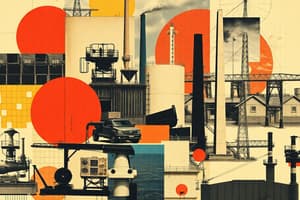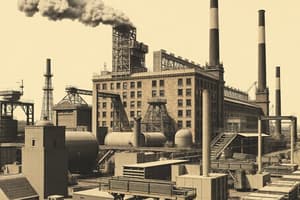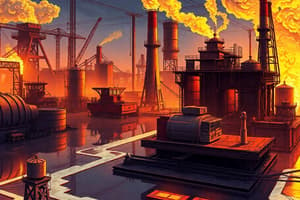Podcast
Questions and Answers
In the context of globalized manufacturing, what strategic imperative transcends mere self-sufficiency for a nation aiming to establish a competitive edge in the international market?
In the context of globalized manufacturing, what strategic imperative transcends mere self-sufficiency for a nation aiming to establish a competitive edge in the international market?
- Achieving parity in the quality of manufactured goods with global standards. (correct)
- Subsidizing production costs to undercut international competitors.
- Maintaining import tariffs to protect nascent industries.
- Prioritizing domestic consumption over export-oriented production.
Considering Porter's Diamond Model, which element is MOST directly enhanced by the geographical concentration of the cotton textile industry in Maharashtra and Gujarat during its early development?
Considering Porter's Diamond Model, which element is MOST directly enhanced by the geographical concentration of the cotton textile industry in Maharashtra and Gujarat during its early development?
- Related and supporting industries.
- Government policies.
- Demand conditions.
- Factor conditions. (correct)
What is the MOST significant challenge to the full utilization of India's high-quality spun yarn in its domestic weaving sector, hindering its ability to compete globally in fabric production?
What is the MOST significant challenge to the full utilization of India's high-quality spun yarn in its domestic weaving sector, hindering its ability to compete globally in fabric production?
- The decentralized nature of weaving, limiting the adoption of high-quality yarn. (correct)
- Inadequate investment in modern powerloom technology.
- The higher cost of domestically produced spun yarn compared to imported alternatives.
- A lack of skilled labor in decentralized weaving centers.
After the Partition of 1947, what critical realignment MOST impacted India's jute industry specifically concerning its capacity for raw material procurement?
After the Partition of 1947, what critical realignment MOST impacted India's jute industry specifically concerning its capacity for raw material procurement?
Considering the principle of comparative advantage, what explains the increasing concentration of sugar mills in the southern and western states of India, particularly Maharashtra, DESPITE the historical presence of mills in Uttar Pradesh and Bihar?
Considering the principle of comparative advantage, what explains the increasing concentration of sugar mills in the southern and western states of India, particularly Maharashtra, DESPITE the historical presence of mills in Uttar Pradesh and Bihar?
Within the framework of industrial location theory, what is the MOST critical factor explaining the concentration of iron and steel industries in the Chhotanagpur plateau region?
Within the framework of industrial location theory, what is the MOST critical factor explaining the concentration of iron and steel industries in the Chhotanagpur plateau region?
How has the ready availability of aluminum as a substitute for other metals affected material demand elasticity in various downstream manufacturing sectors?
How has the ready availability of aluminum as a substitute for other metals affected material demand elasticity in various downstream manufacturing sectors?
What is the MOST compelling reason for the widespread dispersion of chemical industries across a country?
What is the MOST compelling reason for the widespread dispersion of chemical industries across a country?
Given India's lack of commercially usable potash reserves, what strategic measure could BEST ensure the long-term sustainability of its fertilizer industry?
Given India's lack of commercially usable potash reserves, what strategic measure could BEST ensure the long-term sustainability of its fertilizer industry?
Considering the principles of sustainable economic development, what is the MOST effective approach to reconcile the economic benefits of the automobile industry in India with its environmental costs?
Considering the principles of sustainable economic development, what is the MOST effective approach to reconcile the economic benefits of the automobile industry in India with its environmental costs?
From a systems thinking perspective, what is the MOST far-reaching consequence of thermal water pollution resulting from industrial processes?
From a systems thinking perspective, what is the MOST far-reaching consequence of thermal water pollution resulting from industrial processes?
How might the principles of circular economy be applied to mitigate the environmental impact of industrial solid waste, such as phospho-gypsum and iron and steel slags, in India?
How might the principles of circular economy be applied to mitigate the environmental impact of industrial solid waste, such as phospho-gypsum and iron and steel slags, in India?
From an environmental economics standpoint, what is the MOST efficient mechanism for internalizing the external costs associated with air pollution from industries?
From an environmental economics standpoint, what is the MOST efficient mechanism for internalizing the external costs associated with air pollution from industries?
Considering the principles of industrial ecology, what strategy would BEST promote a closed-loop system for water usage in industrial processes?
Considering the principles of industrial ecology, what strategy would BEST promote a closed-loop system for water usage in industrial processes?
In the context of sustainable development, what is the MOST significant benefit of integrating economic development with environmental concerns?
In the context of sustainable development, what is the MOST significant benefit of integrating economic development with environmental concerns?
Flashcards
What is Manufacturing?
What is Manufacturing?
Production of goods in large quantities after processing raw materials into more valuable products.
Basic/Key Industries
Basic/Key Industries
Industries that supply products to manufacture other goods.
Consumer Industries
Consumer Industries
Industries that produce goods for direct consumer use.
Public Sector Industries
Public Sector Industries
Signup and view all the flashcards
Private Sector Industries
Private Sector Industries
Signup and view all the flashcards
Joint Sector Industries
Joint Sector Industries
Signup and view all the flashcards
Cooperative Sector Industries
Cooperative Sector Industries
Signup and view all the flashcards
Mineral-Based Industries
Mineral-Based Industries
Signup and view all the flashcards
Iron and Steel Industry
Iron and Steel Industry
Signup and view all the flashcards
Aluminium Smelting
Aluminium Smelting
Signup and view all the flashcards
Fertilizer Industry
Fertilizer Industry
Signup and view all the flashcards
Cement Industry
Cement Industry
Signup and view all the flashcards
Automobile Industry
Automobile Industry
Signup and view all the flashcards
Industrial Pollution
Industrial Pollution
Signup and view all the flashcards
Air Pollution
Air Pollution
Signup and view all the flashcards
Study Notes
- Manufacturing is producing goods in large amounts from raw materials to valuable products.
- Paper is made from wood, sugar from sugarcane, iron and steel from iron ore, while aluminum comes from bauxite.
- Clothes are manufactured from yarn.
- Secondary activities are the manufacturing of primary materials into finished goods.
- Steel factories, car, breweries and textile industries are examples of secondary activities.
- The manufacturing industries fall in the secondary sector.
- The economic strength of a country is measured by the development of its manufacturing industries.
Importance of Manufacturing
- Manufacturing modernizes agriculture and decreases reliance on agricultural income by creating jobs in secondary and tertiary sectors.
- Industrial development is a precondition for reducing unemployment and poverty.
- Public and joint sector industries in India aimed to reduce regional disparities by locating in tribal and backward areas.
- Exporting manufactured goods increases trade and brings in foreign exchange.
- Countries that convert raw materials into various finished goods of higher value are more prosperous.
- India can increase its prosperity by increasing and diversifying manufacturing industries.
- Agro-industries have boosted agriculture by enhancing productivity.
- Agriculture relies on industries for irrigation pumps, fertilizers, and tools.
- Manufacturing boosts agriculture and makes production more efficient.
- Industries must be efficient and competitive in the present globalized world.
- Manufactured goods must be high quality to compete in the international market.
Classification of Industries
- Industries are classified to better grasp their manufacturing processes.
Based on Source of Raw Materials:
- Agro-based industries use agricultural raw materials like cotton, jute, silk, wool, rubber, sugar, tea, coffee, and edible oil.
- Mineral-based industries use minerals like iron, steel, cement, aluminum and petrochemicals.
According to Main Role:
- Basic or key industries supply raw materials to manufacture other goods, such as iron, steel, copper, and aluminum smelting.
- Consumer industries produce goods for direct consumer use, like sugar, toothpaste, and paper.
Based on Capital Investment:
- A small-scale industry has a maximum investment of ₹1 crore, but this limit has changed over time.
On the Basis of Ownership:
- Public sector industries are owned and operated by government agencies like BHEL and SAIL.
- Private sector industries are owned and run by individuals or groups, such as TISCO and Bajaj Auto Ltd.
- Joint ventures are run by the state and individuals, like Oil India Ltd. (OIL).
- Cooperative sector industries are owned and operated by raw material producers, suppliers, or workers, pooling resources and sharing profits/losses, for example, the sugar industry in Maharashtra.
Based on Bulk and Weight of Raw Material and Finished Goods:
- Heavy industries use heavy raw materials and produce heavy goods like iron and steel.
- Light industries use light materials to produce light goods, such as electrical equipment.
Agro-Based Industries
- Agro-based industries like textiles, sugar, and edible oil rely on agricultural raw materials.
Textile Industry
- The textile industry is unique as it significantly contributes to industrial production, employment, and foreign exchange earnings.
- The textile industry is self-reliant with a complete value chain, from raw materials to high-value products.
Cotton Textiles
- In ancient India, cotton textiles were made using hand spinning and weaving.
- Power-looms were introduced after the 18th century.
- Traditional industries experienced a setback during the colonial period because they could not compete with mill-made cloth from England.
- The first successful textile mill was established in Mumbai in 1854.
- The development of the cotton textile industry was boosted during the two World Wars
- The industry was initially concentrated in the cotton-growing regions of Maharashtra and Gujarat due to raw cotton availability, markets, transport and accessible ports and moist climate.
- The textile industry supports agriculture and provides livelihoods to farmers and workers involved in ginning, spinning and weaving.
- It also supports other industries like chemicals, dyes, packaging and engineering.
- Spinning is centralized in Maharashtra, Gujarat, and Tamil Nadu.
- Weaving is decentralized, incorporating regional skills and designs.
- India excels in spinning but struggles with weaving high-quality yarn.
- Weaving methods include handloom, power loom, and mills.
- Handspun Khadi provides employment to weavers in their homes as a cottage industry.
Jute Textiles
- India is the largest producer of raw jute and jute goods.
- India is second after Bangladesh in exporting jute.
- Jute mills are mainly in West Bengal along the Hugli River banks.
- Rishra near Kolkata was the location of the first jute mill was in 1855.
- After the Partition in 1947, most of the jute producing area became Bangladesh (formerly East Pakistan).
Sugar Industry
- India ranks second in sugar production worldwide.
- India is first in producing gur and khandsari.
- The raw material for sugar production is bulky, and its sucrose content decreases during transport.
- Sugar mills are in Uttar Pradesh, Bihar, Maharashtra, Karnataka, Tamil Nadu, Andhra Pradesh, Gujarat, Punjab, Haryana, and Madhya Pradesh.
- Sixty percent of sugar mills are in Uttar Pradesh and Bihar.
- The sugar industry is seasonal and suits the cooperative sector.
- Sugar mills are shifting to southern and western states like Maharashtra.
- The cane in these areas has higher sucrose content, and the cooler climate extends the crushing season and cooperatives are more successful.
Mineral-Based Industries
- Industries using minerals and metals as raw materials are mineral-based.
Iron and Steel Industry
- The iron and steel industry is the foundation for all other industries (heavy, medium, light) since they rely on it for machinery.
- Steel is essential for manufacturing, construction, defense, medical equipment, and consumer goods.
- Production and consumption of steel reflects a country's development.
- It's a heavy industry because raw materials and finished goods are heavy.
- Ideal ratios of iron ore to coking coal to limestone required in iron and steel production are 4:2:1.
- Manganese is necessary to harden the steel.
- Steel plants need to be located where there is efficient transport for distribution..
Aluminium Smelting
- Aluminium smelting is the second most important metallurgical industry in India.
- Aluminium is light, corrosion-resistant, heat-conductive, malleable, and strong when mixed with other metals.
- It is used in aircraft, utensils, and wires.
- Aluminium has become a substitute for steel, copper, zinc, and lead across industries.
- Aluminium smelting plants are in Odisha, West Bengal, Kerala, Uttar Pradesh, Chhattisgarh, Maharashtra, and Tamil Nadu.
- Bauxite is the main raw material for aluminium smelters.
- Consistent electricity supply and a reliable source of raw material at minimal cost are vital for industry location.
Chemical Industries
- The chemical industry is rapidly growing and diversifying in India, comprising large and small manufacturing units.
- Both inorganic and organic sectors have shown quick growth.
- Sulphuric acid, nitric acid, alkalies, soda ash, and caustic soda are inorganic chemicals.
- Petrochemicals are organic chemicals used for synthetic fibres, rubbers, plastics, drugs and pharmaceuticals.
- Chemical plants are near oil refineries or petrochemical facilities.
- The chemical industry is its own primary consumer as basic chemicals are processed to produce chemicals for industry and agriculture.
Fertilizer Industry
- The fertilizer industry focuses on producing nitrogenous fertilizers, phosphatic fertilizers, ammonium phosphate (DAP) and complex fertilizers.
- Potash is entirely imported into India due to lack of reserves.
- The industry expanded after the Green Revolution.
- Gujarat, Tamil Nadu, Uttar Pradesh, Punjab, and Kerala produce half of the fertilizers.
Cement Industry
- Cement is essential for constructing buildings, factories, bridges, roads, airports, and dams.
- Bulky raw materials, like limestone, silica, and gypsum, are needed alongside coal and energy.
- The industry strategically locates plants in Gujarat for access to Gulf countries.
- The first cement plant was established in Chennai in 1904, and the industry has expanded since Independence.
Automobile Industry
- Automobiles enable quick transportation of goods, services and passengers with various centers manufacturing trucks, buses, cars, motorcycles and scooters.
- Demand for vehicles has increased after liberalization and introduction of modern models.
- The industry is located around Delhi, Gurugram, Mumbai, Pune and Chennai.
Information Technology and Electronics Industry
- The electronics industry produces a range of goods from transistor sets to computers.
- Bengaluru is India's electronic capital.
- Other electronic centers are Mumbai, Delhi, Hyderabad, Pune and Chennai.
- The industry mainly concentrates in Bengaluru, Noida, Mumbai, Chennai and Pune.
- It has greatly impacted employment, and hardware and software growth drives the IT industry in India.
Industrial Pollution and Environmental Degradation
- Industries pollute land, water, air, and cause noise, degrading the environment, despite contributions to economic growth.
- Air pollution is due to high levels of undesirable gases (sulfur dioxide and carbon monoxide), airborne particles (dust, sprays, and smoke).
- Paper factories, refineries, and burning fossil fuels release contaminants.
- Toxic gas leakage has long-term harm.
- Water pollution arises from organic and inorganic industrial waste released into rivers.
- The main contributors are paper, chemical, textile, petroleum, and electroplating industries, as well as pesticides, fertilizers, and plastic factories.
- Thermal pollution occurs when hot factory water is released into rivers and ponds without cooling, which endangers aquatic life.
- Soil and water contamination are interconnected.
- Dumping wastes contaminates the soil, pollutes groundwater.
- Noise pollution causes irritation, hearing impairment, and increased heart rate caused by industrial operations and equipment.
Control of Environmental Degradation
- Minimize water use by reusing and recycling to lower industrial pollution of fresh water.
- Harvesting rainwater also helps reduce usage.
- Treat hot water and industrial waste before releasing them into rivers and ponds.
- Industrial effluent treatment involves: primary treatment (mechanical), secondary (biological), and tertiary (biological, chemical, and physical processes).
- Regulate groundwater extraction, reduce air particulate matter with smoke stacks, electrostatic precipitators and use oil or gas for fuel.
NTPC (National Thermal Power Corporation)
- NTPC has ISO certification for its environmental management and preserves the environment through equipment upgrades.
- NTPC reduces waste by maximizing ash utilization and has green belts and specialized vehicles for afforestation.
- The environmental pollution is reduced through ash pond and water management while there is ecological monitoring and online database management.
Studying That Suits You
Use AI to generate personalized quizzes and flashcards to suit your learning preferences.




